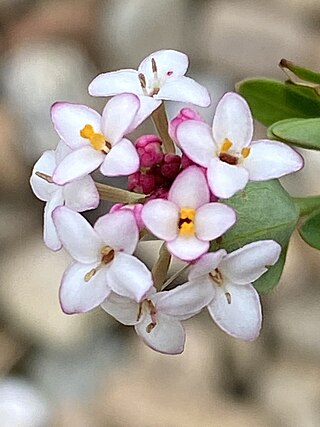
Pimelea spicata, commonly known as the spiked rice flower, is a flowering plant in the family Thymelaeaceae and is endemic to New South Wales. It is a slender plant with white flowers and elliptic leaves.

Pimelea microcephala, commonly known as mallee rice-flower or shrubby rice-flower is a species of flowering plant in the family Thymelaeaceae and is endemic to mainland Australia. It is an erect shrub with compact heads of male or female, white to yellow or greenish flowers on separate plants, the heads surrounded by 2 or 4 leaf-like involucral bracts.

Pimelea humilis, also known as common riceflower or dwarf riceflower, is a species of flowering plant in the family Thymelaeaceae and is endemic to south-eastern Australia. It is an erect or scrambling shrub with hairy stems, elliptic to lance-shaped leaves and heads of 12 to 52 of creamy-white, bisexual or female flowers.

Pimelea spinescens, commonly known as plains rice-flower, spiny rice-flower or prickly pimelea, is a species of flowering plant in the family Thymelaeaceae and is endemic to Victoria. It is a spreading undershrub with elliptic leaves arranged in opposite pairs, and heads of white, cream-coloured or yellow flowers surrounded by 4 elliptic, leaf-like involucral bracts.

Pimelea serpyllifolia, commonly known as thyme riceflower, is a species of flowering plant in the family Thymelaeaceae and is endemic to southern Australia. It is an erect shrub with narrowly elliptic to spatula-shaped leaves, and compact heads of 4 to 12 yellow, yellowish-green or white flowers surrounded by 2 or 4 leaf-like involucral bracts. Male and female flowers are borne on separate plants.

Pimelea ligustrina is a species of flowering plant in the family Thymelaeaceae, and is endemic to south-eastern Australia. It is a shrub with lance-shaped or narrowly elliptic leaves arranged in opposite pairs, and clusters of creamy-white, white or pinkish flowers usually surrounded by 4 or 8, greenish to reddish brown involucral bracts.

Pimelea drupacea, commonly known as cherry rice-flower, is a species of flowering plant in the family Thymelaeaceae and is endemic to south-eastern Australia. It is a shrub with elliptic leaves arranged in opposite pairs, and head-like clusters of white, tube-shaped flowers surrounded by two or four leaves.
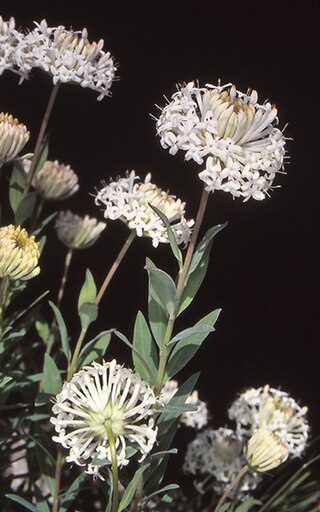
Pimelea treyvaudii, commonly known as grey rice-flower, is a species of shrub in the family Thymelaeaceae. It has white flowers in spherical heads at the end of branches and is endemic to eastern Australia.

Pimelea curviflora, also known as curved rice-flower, is a shrub in the family Thymelaeaceae and is endemic to Australia. It is a small, hairy shrub with greenish-yellow or red tubular flowers.
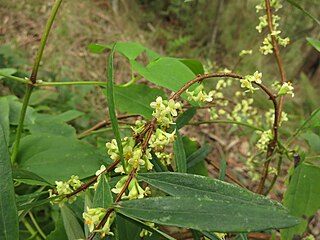
Pimelea axiflora, commonly known as bootlace bush, is a small shrub in the family Thymelaeaceae and is endemic to Australia. It is a small shrub with whitish flowers on mostly smooth stems.
Pimelea biflora, commonly known as matted rice-flower, is a species of flowering plant in the family Thymelaeaceae and is endemic to south-eastern continental Australia. It is a prostrate, mat-forming shrub with elliptic leaves and dark red flowers always arranged in pairs on the ends of branches.

Pimelea trichostachya, commonly known as annual riceflower, spiked riceflower or flax weed, is a species of flowering plant in the family Thymelaeaceae and is endemic to continental Australia. It is a slender, semi-woody, annual shrub with narrowly elliptic or linear leaves and densely hairy, white or yellow flowers and green, purple-tinged fruit. It is toxic to livestock.
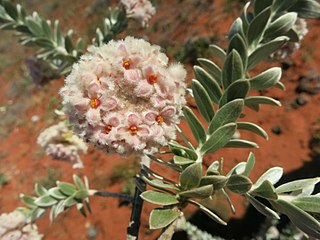
Pimelea interioris is a species of flowering plant in the family Thymelaeaceae and is endemic to a restricted part of the south of the Northern Territory of Australia. It is a shrub with hairy, narrowly elliptic leaves and clusters of creamy-white to pale yellow, separate male and female flowers.
Pimelea macrostegia is a species of flowering plant in the family Thymelaeaceae and is endemic to Kangaroo Island in South Australia. It is a shrub with glabrous, narrowly elliptic leaves and clusters of pale yellow flowers surrounded by 4 or 6 egg-shaped, pale green involucral bracts.
Pimelea micrantha, commonly known as silky rice-flower is a species of flowering plant in the family Thymelaeaceae and is endemic to southern Australia. It is a much-branched undershrub with narrowly elliptic to lance-shaped leaves and compact clusters or heads of densely hairy, creamy white flowers.
Pimelea penicillaris, commonly known as sandhill riceflower, is a species of flowering plant in the family Thymelaeaceae and is endemic to Central Australia. It is an erect, dioecious shrub with densely hairy young stems, densely hairy, pale silvery green, elliptic leaves, and compact heads of white to yellow or pink flowers surrounded by 6 to 12 silky-hairy, silvery or brownish involucral bracts.
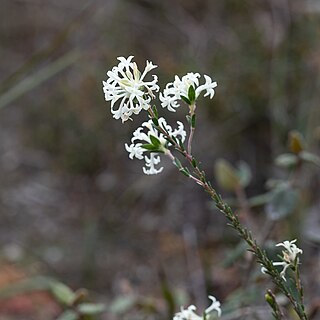
Pimelea phylicoides, commonly known as heath rice-flower, is a species of flowering plant in the family Thymelaeaceae and is endemic to southern continental Australia. It is an erect shrub with densely hairy young stems, narrowly egg-shaped to elliptic leaves, and heads of white flowers surrounded by 3 to 6 involucral bracts.

Pimelea simplex, commonly known as desert rice-flower, is a species of flowering plant in the family Thymelaeaceae and is endemic to inland Australia. It is a herb or semi-woody annual with narrowly elliptic to linear leaves, and compact heads of densely hairy white to yellowish-green flowers.

Pimelea stricta, commonly known as gaunt rice-flower, is a species of flowering plant in the family Thymelaeaceae and is endemic to south-eastern continental Australia. It is an erect shrub with narrowly elliptic or linear leaves, and compact heads of densely hairy, creamy-white to yellow flowers surrounded by 4 egg-shaped involucral bracts.

Pimelea umbratica, is a species of flowering plant in the family Thymelaeaceae and is endemic to eastern Australia. It is a shrub with densely hairy young stems, narrowly elliptic or more or less oblong leaves, and white flowers arranged singly, or in small groups, in leaf axils.















